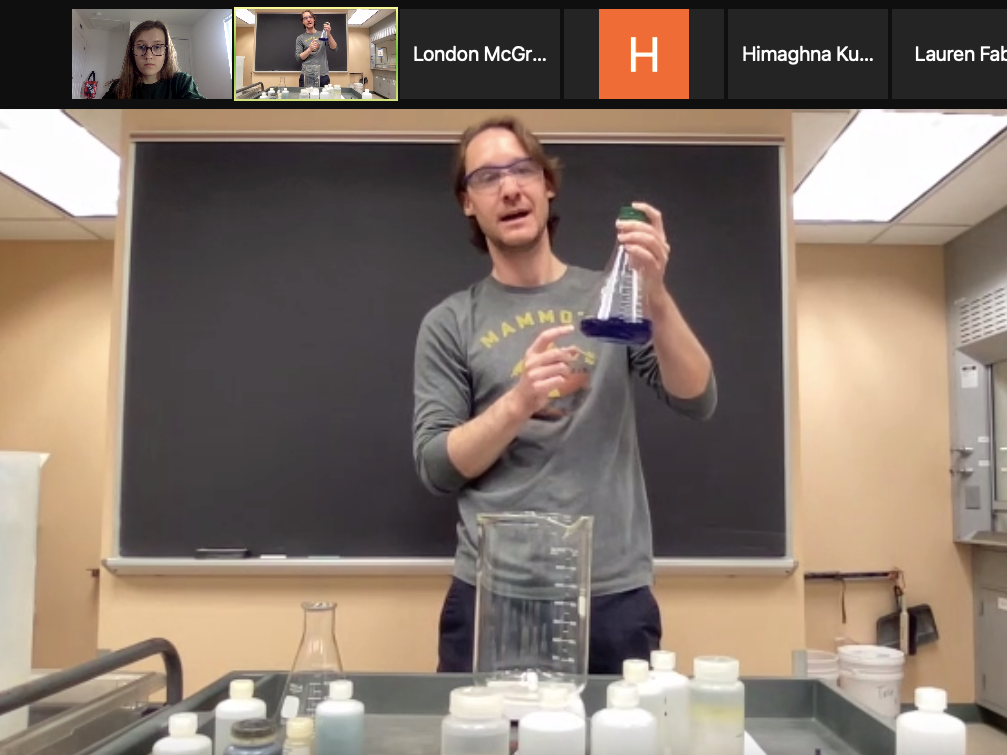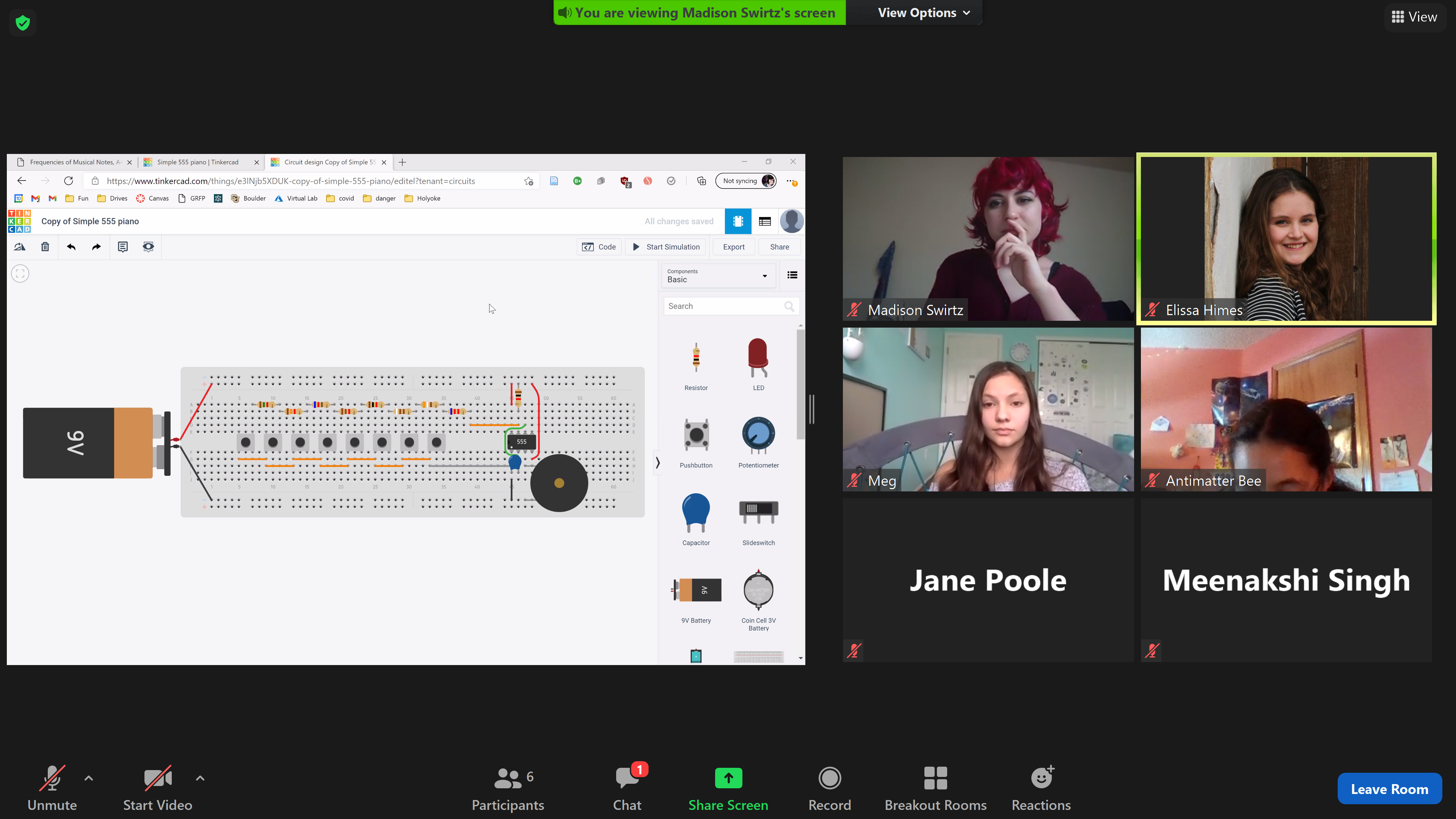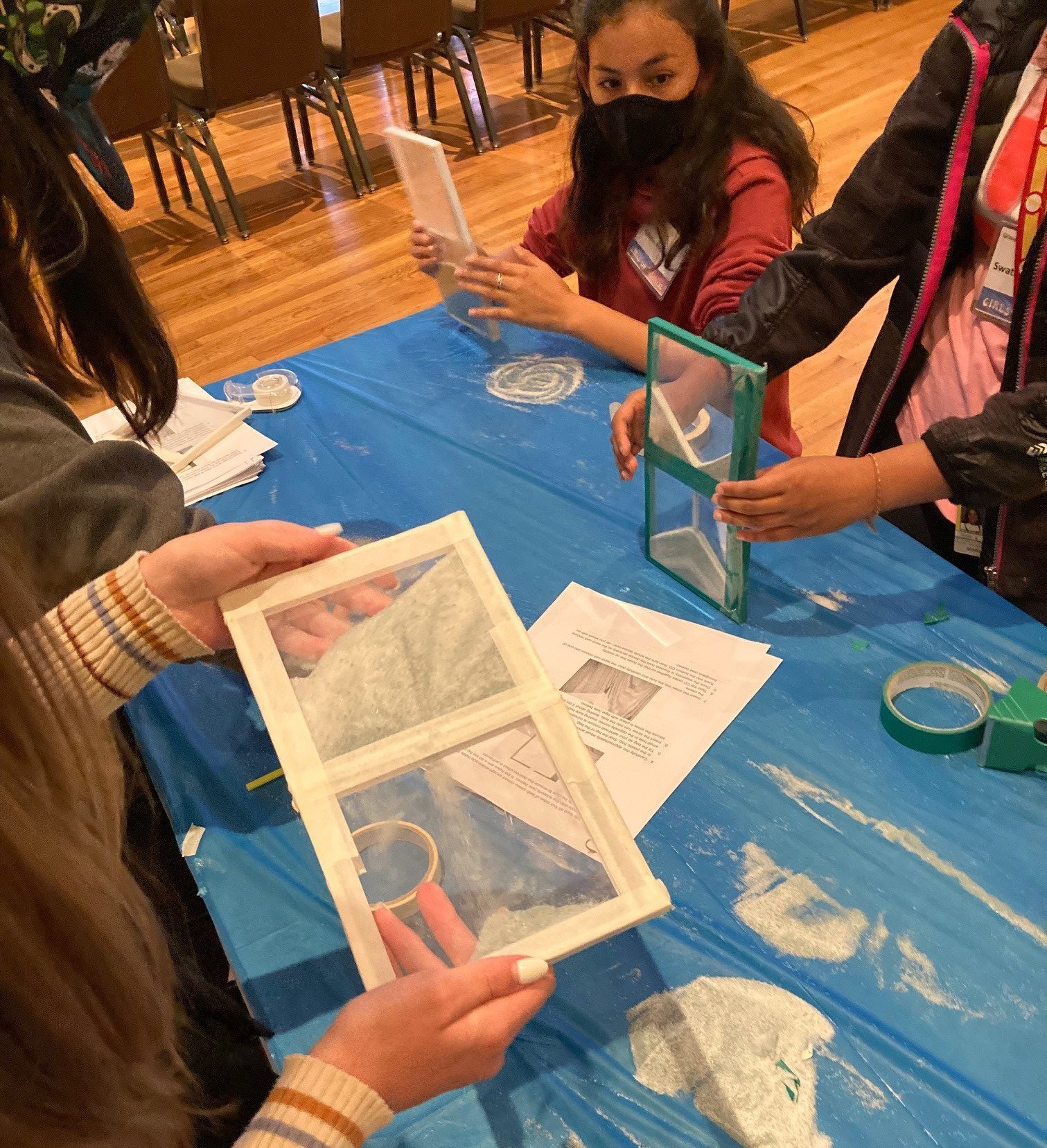Program Overview
COVID-19 continues to disproportionately impact underrepresented and under-resourced communities across the state and country, specifically rural and communities of color. A silver-lining this pandemic presents is an opportunity to expand access to Mines and our outstanding K-12 outreach programs through virtual classroom experiences. The K-12 Virtual Classroom Takeover aims to inspire the next generation of scientists and engineers by sending Mines students or faculty to classrooms across the state of Colorado. The experience involves “zooming” into classrooms for a 50-minute “takeover,” and includes a short interactive STEM demo, an overview of Mines and a question and answer panel. A box of activity supplies and cool Mines swag is mailed to each teacher just in time for the experience. Each lesson is tailored to the grade level and at least one state of Colorado’s science educational standards. There is no cost to participate.
Program Objectives
- Expose students to different majors at Mines and their application to a variety of industries.
- Inspire the next generation of scientists and engineers through impactful K-12 outreach and meaningful engagement.
- Highlight the diversity found within STEM disciplines and Mines students.
- Expand access to Mines outreach programming to school districts in Colorado that are unable to attend in-person events due to distance, cost or both.
- Elevate Mines to top-of-mind for college bound students across the state of Colorado.
Request a classroom takeover
After reviewing the projects available by grade level, you’re ready to request a date. Let’s go! Just click on the ‘Request Form’ Button in each grade level drop down. Please build in at minimum a three week lead-time so supplies can arrive to your classroom in time for the virtual visit. Our students are excited to meet yours!
Projects available by grade level



Grades 1-2
Simple instruments: harmonicas
Project description:
Let’s make a simple instrument to discuss and understand the concept of frequency and vibrating matter can make sound. Using simple materials to make a harmonica, students will be able to create sound. This will spark a discussion on the types of sound waves and how energy can generate sounds.
Alignment with Colorado State Standards:
Sound can make matter vibrate and vibrating matter can make sound.
facilitators’ availability:
Monday: 2:00-3:00 PM
Tuesday: 1:00-3:00 PM
Wednesday: 2:00-3:00 PM
Thursday: 1:00-3:00 PM
Friday: noon-3:00 PM
All times are Mountain Standard Time
Request Form
Grades 2-3 (option 1)
Squishy Circuits
Project description:
This project will appeal to the creativity of students while also enhancing their knowledge about circuits, energy and electrical engineering. Students will be given the opportunity to construct a simple circuit consisting of a light and a battery. Insulative and conductive materials will also be introduced, and this is where creativity can shine as students can use Play-Doh and clay to implement their circuits into an endless possibility of structures and shapes. The classroom will be filled with light up creations and brighten the minds of students as they learn about electricity.
Alignment with Colorado State Standards:
Objects in contact exert forces on each other; electric and magnetic forces between a pair of objects do not require contact.
facilitators’ availability:
Monday: 8:00-10:00 AM
Tuesday: 8:00-9:00 AM
Wednesday: 8:00-10:00 AM
Thursday: 8:00-9:00 AM, 10:30 AM-noon
Friday: 8:00-10:00 AM, noon-1:00 PM
All times are Mountain Standard Time
Request Form
Grades 2-3 (option 2)
candy erosion
Project description:
Let’s run an experiment on how erosion affects different materials in the form of hard and soft candies. This experiment will help discuss how some things on earth occur quickly or slowly and how wind and water are capable of changing earth’s surface. During the experiment, students will conduct tests to see how both fast- and slow-moving water impacts certain types of candies.
Alignment with Colorado State Standards:
Wind and water can change the shape of the land; models can show the shape and these changes to the land.
facilitators’ availability:
Monday: 2:00-3:00 PM
Tuesday: 1:00-3:00 PM
Wednesday: 2:00-3:00 PM
Thursday: 1:00-3:00 PM
Friday: noon-3:00 PM
All times are Mountain Standard Time
Request Form
Grades 3-4 (option 1)
Squishy Circuits
Project description:
This project will appeal to the creativity of students while also enhancing their knowledge about circuits, energy and electrical engineering. Students will be given the opportunity to construct a simple circuit consisting of a light and a battery. Insulative and conductive materials will also be introduced, and this is where creativity can shine as students can use Play-Doh and clay to implement their circuits into an endless possibility of structures and shapes. The classroom will be filled with light up creations and brighten the minds of students as they learn about electricity.
Alignment with Colorado State Standards:
Objects in contact exert forces on each other; electric and magnetic forces between a pair of objects do not require contact. Energy can be moved from place to place. Energy can be produced, used or released by converting stored energy.
facilitators’ availability:
Monday: 8:00-10:00 AM
Tuesday: 8:00-9:00 AM
Wednesday: 8:00-10:00 AM
Thursday: 8:00-9:00 AM, 10:30 AM-noon
Friday: 8:00-10:00 AM, noon-1:00 PM
All times are Mountain Standard Time
Request Form
Grades 3-4 (option 2)
how to make a seismograph
Project description:
Let’s make a seismograph to discuss natural disasters and their impact they have on human nature and how we are able to combat them. Seismographs are the how earthquakes are measured and help in reducing the impact they can cause. This activity will allow students to discuss natural disasters and how they occur and dive a little deeper into how earthquakes happen and how they are combated.
Alignment with Colorado State Standards:
A variety of weather hazards result from natural process; humans cannot eliminate weather-related hazards but can reduce their impacts.
facilitators’ availability:
Monday: 2:00-3:00 PM
Tuesday: 1:00-3:00 PM
Wednesday: 2:00-3:00 PM
Thursday: 1:00-3:00 PM
Friday: noon-3:00 PM
All times are Mountain Standard Time
Request Form
Grades 4-5
Squishy Circuits
Project description:
This project will appeal to the creativity of students while also enhancing their knowledge about circuits, energy and electrical engineering. Students will be given the opportunity to construct a simple circuit consisting of a light and a battery. Insulative and conductive materials will also be introduced, and this is where creativity can shine as students can use Play-Doh and clay to implement their circuits into an endless possibility of structures and shapes. The classroom will be filled with light up creations and brighten the minds of students as they learn about electricity.
Alignment with Colorado State Standards:
Energy can be moved from place to place. Energy can be produced, used or released by converting stored energy.
facilitators’ availability:
Monday: 8:00-10:00 AM
Tuesday: 8:00-9:00 AM
Wednesday: 8:00-10:00 AM
Thursday: 8:00-9:00 AM, 10:30 AM-noon
Friday: 8:00-10:00 AM, noon-1:00 PM
All times are Mountain Standard Time
Request Form
Grades 5-6
impact cratering
Project description:
The solar system is a dynamic environment, which Earth is a part of. Collisions between planets, moons and smaller bodies, such as asteroids and comets, create impact craters, a process which is illustrated today by the pocketed surface of the Moon. In this demonstration, we will create our own impact craters to see what these features tell us about the histories and properties of planets, such as Earth, moons and asteroids. The classroom will be divided into groups of 3. Each group will create their own “planet” using flour, sprinkles and cocoa powder, and then create impacts on the surface using jellybeans and marshmallows. Students will learn how processes on Earth shape the surface over time and remove traces of these impacts.
Alignment with Colorado State Standards:
Earth’s major systems interact in multiple ways to affect Earth’s surface materials and processes.
Facilitators’ availability:
Monday: 1:00-3:30 PM
Tuesday: 1:00-3:30 PM
Wednesday: 9:00-11:30 AM
Thursday: 1:00-3:30 PM
Friday: 9:30 AM-3:30 PM
All times are Mountain Standard Time
Request Form
Grades 7-8
Chromatography of Colors
Project description:
Chromatography is a technique used by chemists to separate chemicals. In this activity, students will create their own system of chromatography using coffee filters, water and colored markers. Each student will set up their own chromatography system, but markers can be shared. Groups of three (with at least one student testing the black, brown or gray marker) will compare a variety of colored markers. This will show students how different pigments found in colored markers can separate using a chromatography technique.
Alignment with Colorado State Standards:
The fact that matter is composed of atoms and molecules can be used to explain the properties of substances, diversity of materials, states of matter and phases changes.
Classroom teacher provides:
- 1 Gallon of water
Facilitators’ availability:
Monday: 8:00-9:00 AM, 11:00 AM-2:00 PM
Tuesday: 8:00 AM-3:00 PM
Wednesday: 8:00-9:00 AM, noon-3:00 PM
Thursday: 8:00 AM-2:00 PM
Friday: noon-3:00 PM
All times are Mountain Standard Time
Request Form
Grades 8-9
Chromatography of Colors
Project description:
Chromatography is a technique used by chemists to separate chemicals. In this activity, students will create their own system of chromatography using coffee filters, water and colored markers. Each student will set up their own chromatography system, but markers can be shared. Groups of three (with at least one student testing the black, brown or gray marker) will compare a variety of colored markers. This will show students how different pigments found in colored markers can separate using a chromatography technique.
Alignment with Colorado State Standards:
Energy cannot be created or destroyed, but it can be transported from one place to another and transferred between systems.
Classroom teacher provides:
- 1 Gallon of water
Facilitators’ availability:
Monday: 8:00-9:00 AM, 11:00 AM-2:00 PM
Tuesday: 8:00 AM-3:00 PM
Wednesday: 8:00-9:00 AM, noon-3:00 PM
Thursday: 8:00 AM-2:00 PM
Friday: noon-3:00 PM
Request Form
Grades 9-10 (option 1)
Turtle Graphics in Python
Project description:
This project aims to introduce students to the use of graphics using a simple programming language, Python. Most introductory coding is very much text based, so we try to break through that and introduce some graphics! Turtle is a built-in library of Python that allows users to create graphics using objects. We will introduce this library and then give an introduction to class and objects, both important components to an object-oriented language. Students will make use of an online Python complier to build their very own Turtle game that they can control. Depending on the level of knowledge that students possess, we can tailor the lesson in terms of the amount of starter code that is provided.
Alignment with Colorado State Standards:
The process of programming involves solving computational problems. Collaborative tools, methods and strategies can be used to design, develop and update computational artifacts.
Classroom teacher provides:
- Computer Lab
Facilitators’ availability
Monday: noon-1:00 PM
Thursday: 10:00-11:00 AM
Friday: 8:00-10:00 AM, noon-1:00 PM, 3:00-4:00 PM
All times are Mountain Standard Time
Request Form
Grades 9-10 (Option 2)
Capacitor Circuits
Project description:
In this demo, students in groups of ~3 will measure capacitance through wood, polystyrene and cardboard for different shapes, following along with a fun and engaging worksheet! Students will explore the various dielectric constants and possible applications. We provide the objects ready-made and multiple digital multi-meters to measure the capacitance.
Alignment with Colorado State Standards:
Force fields (gravitational, electric, and magnetic) contain energy and can transmit energy across space from one object to another.
facilitators’ availability:
Monday: 8:00-9:00 AM, noon-2:00 PM, 3:00-4:00 PM
Wednesday: 8:00-10:00 AM, 1:00-2:00 PM
Thursday: 8:00-9:00 AM
Friday: 8:00-10:00 AM, 11:00 AM-noon
All times are Mountain Standard Time
Request Form
Grades 10-11 (option 1)
Turtle Graphics in Python
Project description:
This project aims to introduce students to the use of graphics using a simple programming language, Python. Most introductory coding is very much text based, so we try to break through that and introduce some graphics! Turtle is a built-in library of Python that allows users to create graphics using objects. We will introduce this library and then give an introduction to class and objects, both important components to an object-oriented language. Students will make use of an online Python complier to build their very own Turtle game that they can control. Depending on the level of knowledge that students possess, we can tailor the lesson in terms of the amount of starter code that is provided.
Alignment with Colorado State Standards:
The process of programming involves solving computational problems., Collaborative tools, methods and strategies can be used to design, develop and update computational artifacts.
Classroom teacher provides:
- Computer lab
Facilitators’ availability
Monday: noon-1:00 PM
Thursday: 10:00-11:00 AM
Friday: 8:00-10:00 AM, noon-1:00 PM, 3:00-4:00 PM
All times are Mountain Standard Time
Request Form
Grades 10-11 (option 2)
Capacitor Circuits
Project description:
In this demo, students in groups of ~3 will be measuring capacitance through wood, polystyrene and cardboard for different shapes, following along with a fun and engaging worksheet! Students will explore the various dielectric constants and possible applications. We provide the objects ready-made and multiple digital multi-meters to measure the capacitance.
Alignment with Colorado State Standards:
Force fields (gravitational, electric, and magnetic) contain energy and can transmit energy across space from one object to another.
facilitators’ availability:
Monday: 8:00-9:00 AM, noon-2:00 PM, 3:00-4:00 PM
Wednesday: 8:00-10:00 AM, 1:00-2:00 PM
Thursday: 8:00-9:00 AM
Friday: 8:00-10:00 AM, 11:00 AM-noon
All times are Mountain Standard Time
Request Form
Grades 11-12 (option 1)
The Michelson Interferometry
Project description:
This experiment serves as an introduction to laser interferometry. This technique is vital in physical applications such as the measurement of gravitational waves, laser gyroscopes, and much more. The experiment and lecture are also an introduction to quantum mechanics and its mysterious nature. Students will experience one of the founding quantum mechanics experiments.
The experiment is constructed with a laser, mirror and beam splitter (lasers are of class 3A in the milliwatt range). The laser enters the beam splitter and splits into two beams each with half of the power of the initial beam. A mirror then reflects one of the beam splits directly back into the beam splitter. If this is done at a precise angle, a diffraction pattern will appear at the output. The diffraction pattern is a result of the incoming beam interacting with itself destructively and constructively in its wave-like nature. This further proves the wave-particle duality of light and lays a framework for quantum mechanics.
This project will touch on the classical and quantum mechanical interpretation of the sub-atomic structural model and address the properties of waves.
Alignment with Colorado State Standards:
Waves have characteristic properties and behaviors.
Both an electromagnetic wave model and photon model explain features of electromagnetic radiation broadly and describe common applications of electromagnetic radiation.
Facilitators’ availability
Friday: noon-1:00 PM
All times are Mountain Standard Time
Request Form
Grades 11-12 (option 2)
Capacitor Circuits
Project description:
In this demo, students in groups of ~3 will be measuring capacitance through wood, polystyrene, and cardboard for different shapes, following along with a fun and engaging worksheet! Students will explore the various dielectric constants and possible applications. We provide the objects ready-made and multiple digital multi-meters to measure the capacitance. This project is facilitated by the Mines Society of Physics Students, who will express in the panel segment what it is like to be a physicist.
Alignment with Colorado State Standards:
Force fields (gravitational, electric, and magnetic) contain energy and can transmit energy across space from one object to another.
Facilitators’ availability
Friday: noon-1:00 PM
All times are Mountain Standard Time